Investigation of Groundwater Withdrawal and Recharge Affecting Underground Structures in the Shanghai Urban Area
Abstract
:1. Introduction
2. Case Study
3. Methodology
3.1. Anti-Uprush Calculation
3.2. Anti-Buoyancy Calculation
4. Application of the Methodology on Real Case Study
4.1. Characteristics of Groundwater Withdrawal and Recharge
4.2. Characteristics of Groundwater Head
4.3. Relationship Between Groundwater Head and Net Withdrawal
5. Results and Discussion
5.1. Analysis of Base Hydraulic Stability
5.2. Anti-Floating Effect of the Underground Structure
6. Conclusions
Author Contributions
Acknowledgments
Conflicts of Interest
References
- Xu, Y.S.; Shen, S.L.; Cai, Z.Y.; Zhou, G.Y. The state of land subsidence and prediction approaches due to groundwater withdrawal in China. Nat. Hazards 2008, 45, 123–135. [Google Scholar] [CrossRef]
- Galloway, D.L.; Burbey, T.J. Review: Regional land subsidence accompanying groundwater extraction. Hydrogeol. J. 2011, 19, 1459–1486. [Google Scholar] [CrossRef]
- Chai, J.C.; Shen, S.L.; Zhu, H.H.; Zang, X.L. Land subsidence due to groundwater drawdown in Shanghai. Geotechnique 2004, 54, 143–147. [Google Scholar] [CrossRef]
- Xu, Y.S.; Shen, S.L.; Du, Y.J. Geological and hydrogeological environment in Shanghai with geohazards to construction and maintenance of infrastructures. Eng. Geol. 2009, 109, 241–254. [Google Scholar] [CrossRef]
- Xu, Y.S.; Ma, L.; Du, Y.J.; Shen, S.L. Analysis of urbanization-induced land subsidence in Shanghai. Nat. Hazards 2012, 63, 1255–1267. [Google Scholar] [CrossRef]
- Shen, S.L.; Ma, L.; Xu, Y.S.; Yin, Z.Y. Interpretation of increased deformation rate in aquifer IV due to groundwater pumping in Shanghai. Can. Geotech. J. 2013, 50, 1129–1142. [Google Scholar] [CrossRef]
- Shanghai Geological Environmental Atlas Editorial Board (SGEAEB). Shanghai Geological Environmental Atlas (SGEA); Geology Press: Beijing, China, 2002. (In Chinese) [Google Scholar]
- Shen, S.L.; Xu, Y.S. Numerical evaluation of land subsidence induced by groundwater pumping in Shanghai. Can. Geotech. J. 2011, 48, 1378–1392. [Google Scholar] [CrossRef]
- Luo, Y.; Ye, S.J.; Wu, J.C.; Jiao, X.; Wang, H.M. Characterization of land subsidence during recovery of groundwater levels in Shanghai. Geol. J. China Univers. 2015, 21, 243–254. (In Chinese) [Google Scholar]
- Pujades, E.; Carrera, J.; Jurado, A. Dewatering of a deep excavation undertaken in a layered soil. Eng. Geol. 2014, 178, 15–27. [Google Scholar] [CrossRef]
- Pujades, E.; Simone, S.D.; Carrera, J.; Vázquez-Suñé, E.; Jurado, A. Settlements around pumping wells: Analysis of influential factors and a simple calculation procedure. J. Hydrol. 2017, 548, 225–236. [Google Scholar] [CrossRef]
- Wang, Z.F.; Cheng, W.C.; Wang, Y.Q. Investigation into geohazards during urbanization process of Xi’an, China. Nat. Hazards 2018, 92, 1937–1953. [Google Scholar] [CrossRef]
- Wu, Y.X.; Shen, S.L.; Yuan, D.J. Characteristics of dewatering induced drawdown curve under blocking effect of retaining wall in aquifer. J. Hydrol. 2016, 539, 554–566. [Google Scholar] [CrossRef]
- Wu, Y.X.; Lyu, H.M.; Shen, J.S.; Arulrajah, A. Geological and hydrogeological environment in Tianjin with potential geohazards and groundwater control during excavation. Environ. Earth Sci. 2018, 77, 392. [Google Scholar] [CrossRef]
- Gattinoni, P.; Scesi, L. The groundwater rise in the urban area of Milan (Italy) and its interactions with underground structures and infrastructures. Tunn. Undergr. Space Technol. 2017, 62, 103–114. [Google Scholar] [CrossRef]
- Colombo, L.; Gattinoni, P.; Scesi, L. Stochastic modelling of groundwater flow for hazard assessment along the underground infrastructures in Milan (northern Italy). Tunn. Undergr. Space Technol. 2018, 79, 110–120. [Google Scholar] [CrossRef]
- Wei, Z.X.; Qu, G.Y.; Yan, X.X. Shanghai Urban Geology (SUG); Geology Press: Beijing, China, 2010. (In Chinese) [Google Scholar]
- Shanghai Geology and Mineral Resources Bureau (SGMRB). General Investigation Report of Hydrogeology in Shanghai Region; SGMRB: Shanghai, China, 1987. (In Chinese)
- Xu, Y.S.; Shen, S.L.; Ma, L.; Sun, W.J.; Yin, Z.Y. Evaluation of the blocking effect of retaining walls on groundwater seepage in aquifers with different insertion depths. Eng. Geol. 2014, 183, 254–264. [Google Scholar] [CrossRef]
- Ye, S.J.; Luo, Y.; Wu, J.C.; Yan, X.X.; Wang, H.M.; Jiao, X.; Teatini, P. Three-dimensional numerical modeling of land subsidence in Shanghai, China. Hydrogeol. J. 2016, 24, 695–709. [Google Scholar] [CrossRef]
- Xu, Y.S.; Wu, H.N.; Wang, B.Z.; Yang, T.L. Dewatering induced subsidence during excavation in a Shanghai soft deposit. Environ. Earth Sci. 2017, 76, 351. [Google Scholar] [CrossRef]
- Wu, Y.X.; Shen, S.L.; Xu, Y.S.; Yin, Z.Y. Characteristics of groundwater seepage with cut-off wall in gravel aquifer. I: Field observations. Can. Geotech. J. 2015, 52, 1526–1538. [Google Scholar] [CrossRef]
- Wu, Y.X.; Shen, S.L.; Yin, Z.Y.; Xu, Y.S. Characteristics of groundwater seepage with cut-off wall in gravel aquifer. II: Numerical analysis. Can. Geotech. J. 2015, 52, 1539–1549. [Google Scholar] [CrossRef]
- Wu, Y.X.; Lyu, H.M.; Han, J.; Shen, S.L. Dewatering–induced building settlement around a deep excavation in soft deposit in Tianjin, China. J. Geotech Geoenviron. 2019, 145, 05019003. [Google Scholar] [CrossRef]
- Tan, Y.; Lu, Y. Forensic diagnosis of a leaking accident during excavation. J. Perform. Constr. Fac. ASCE 2017, 31, 04017061. [Google Scholar] [CrossRef]
- Ministry of Construction of the People’s Republic of China (MCPRC). Code for Design of Building Foundation; GB50007-2002; Beijing China Architecture & Building Press: Beijing, China, 2002. (In Chinese) [Google Scholar]
- Market Management Department of Building Material of Shanghai (MMDBMS). Technical Code for Excavation Engineering; DG/TJ08-61-2010; MMDBMS: Shanghai, China, 2010. (In Chinese) [Google Scholar]
- Yang, T.L.; Wang, H.M.; Jiao, X. Land subsidence zoning control in Shanghai. Shanghai Land Resoures 2014, 35, 105–109. (In Chinese) [Google Scholar]
- Wang, H.M. The Risk Assessment System and Risk Management of Land Subsidence in Shanghai. Doctoral dissertation, Shanghai University, Shanghai, China, 2013. (In Chinese). [Google Scholar]
- Li, M.G.; Zhang, Z.J.; Chen, J.J.; Wang, J.H.; Xu, A.J. Zoned and staged construction of an underground complex in Shanghai soft clay. Tunn. Undergr. Space Technol. 2017, 67, 187–200. [Google Scholar] [CrossRef]
- Zhang, Y.Q.; Wang, J.H.; Chen, J.J.; Li, M.G. Numerical study on the responses of groundwater and strata to pumping and recharge in a deep confined aquifer. J. Hydrol. 2017, 548, 342–352. [Google Scholar] [CrossRef]
- Li, M.G.; Xiao, X.; Wang, J.H.; Chen, J.J. Numerical study on responses of an existing metro line to staged deep excavations. Tunn. Undergr. Space Technol. 2019, 85, 268–281. [Google Scholar] [CrossRef]
- Bear, J. Hydraulics of Groundwater; McGraw-Hill: New York, NY, USA, 1979. [Google Scholar]
- Shen, S.L.; Wu, Y.X.; Xu, Y.S.; Hino, T.; Wu, H.N. Evaluation of hydraulic parameter based on groundwater pumping test of multi-aquifer system of Tianjin. Comput. Geotech. 2015, 68, 196–207. [Google Scholar] [CrossRef]
- Li, C.J.; Tang, X.M.; Ma, T.H. Land subsidence caused by groundwater exploitation in the Hangzhou-Jiaxing-Huzhou Plain, China. Hydrogeol. J. 2006, 14, 1652–1665. [Google Scholar] [CrossRef]
- Shi, X.Q.; Xue, Y.Q.; Wu, J.C.; Ye, S.J.; Zhang, Y.; Wei, Z.X.; Yu, J. Characterization of regional land subsidence in Yangtze Delta, China: The example of Su-Xi-Chang area and the city of Shanghai. Hydrogeol. J. 2008, 16, 593–607. [Google Scholar] [CrossRef]
- Hu, J.P.; Shi, B.; Inyang, H.I.; Chen, J.; Sui, Z.X. Patterns of subsidence in the lower Yangtze Delta of China: The case of the Suzhou-Wuxi-Changzhou Region. Environ. Monit. Assess. 2009, 153, 61–72. [Google Scholar] [CrossRef]
- Liu, S.X.; Shen, H.Z.; Zhao, J.K.; Wu, M.J. Geo-environmental effects since the beginning of groundwater exploitation restriction in the Zhejiang coastal plain. J. Geol. Hazards Environ. Preserv. 2013, 24, 37–44. (In Chinese) [Google Scholar]
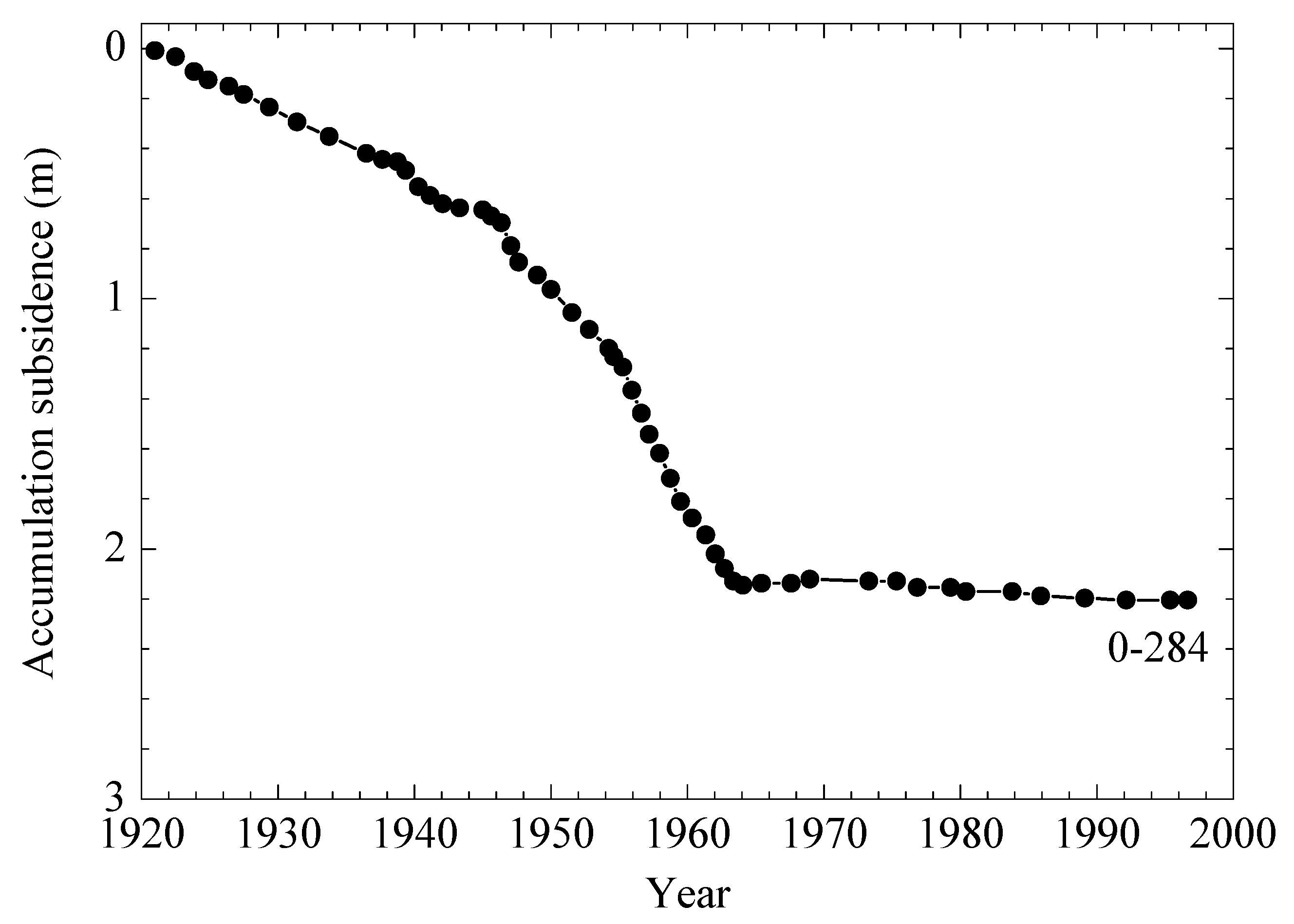
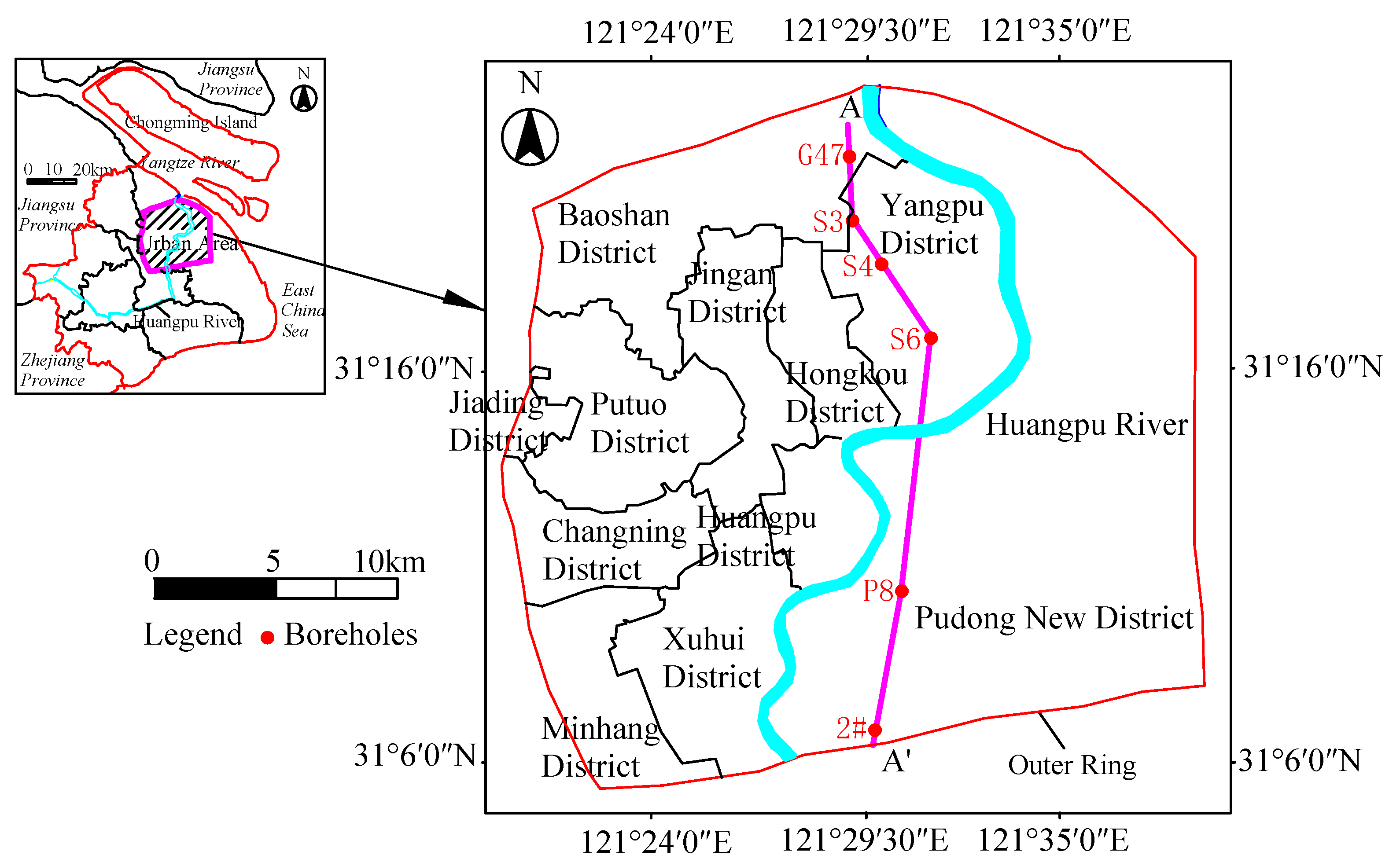
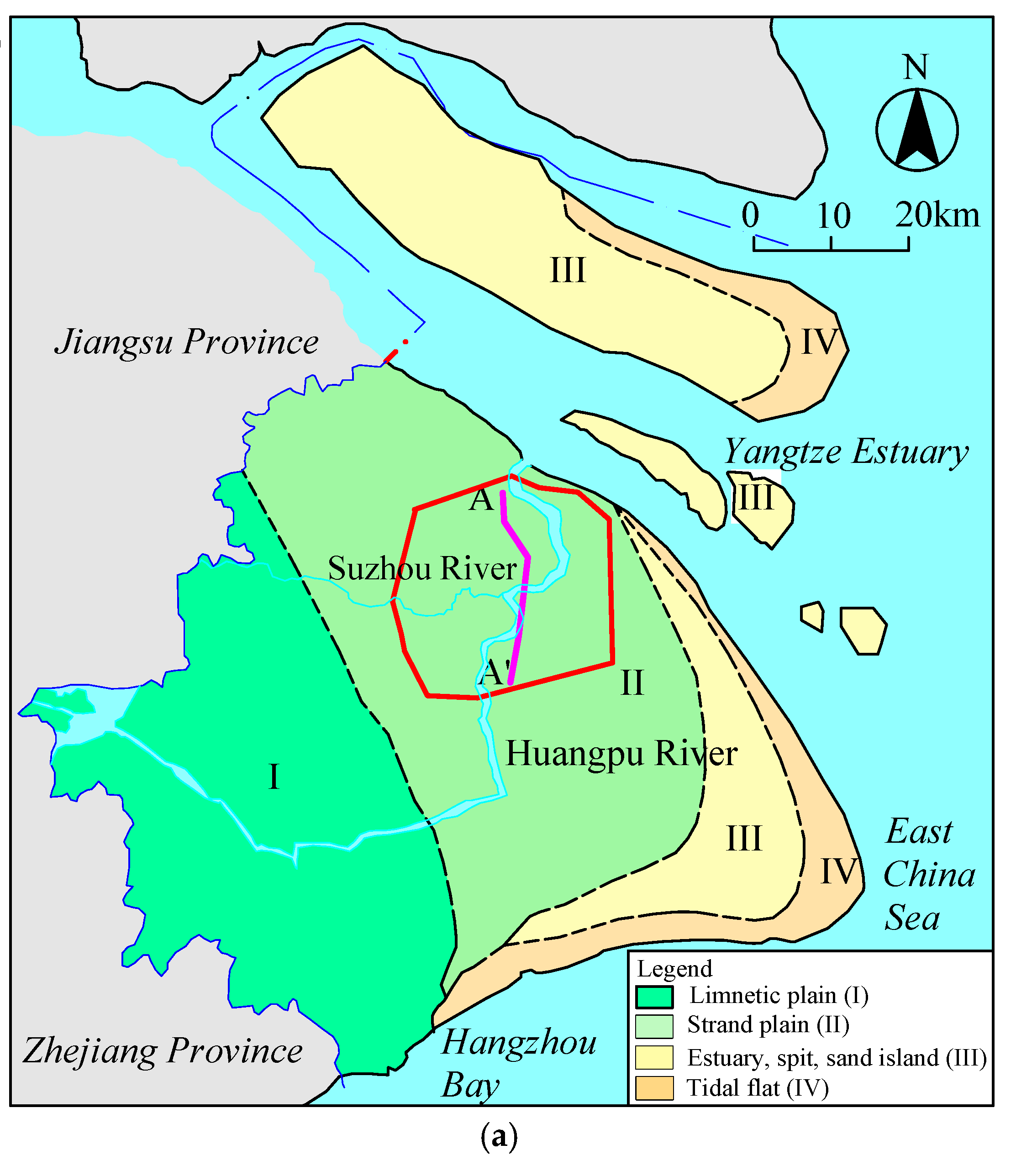
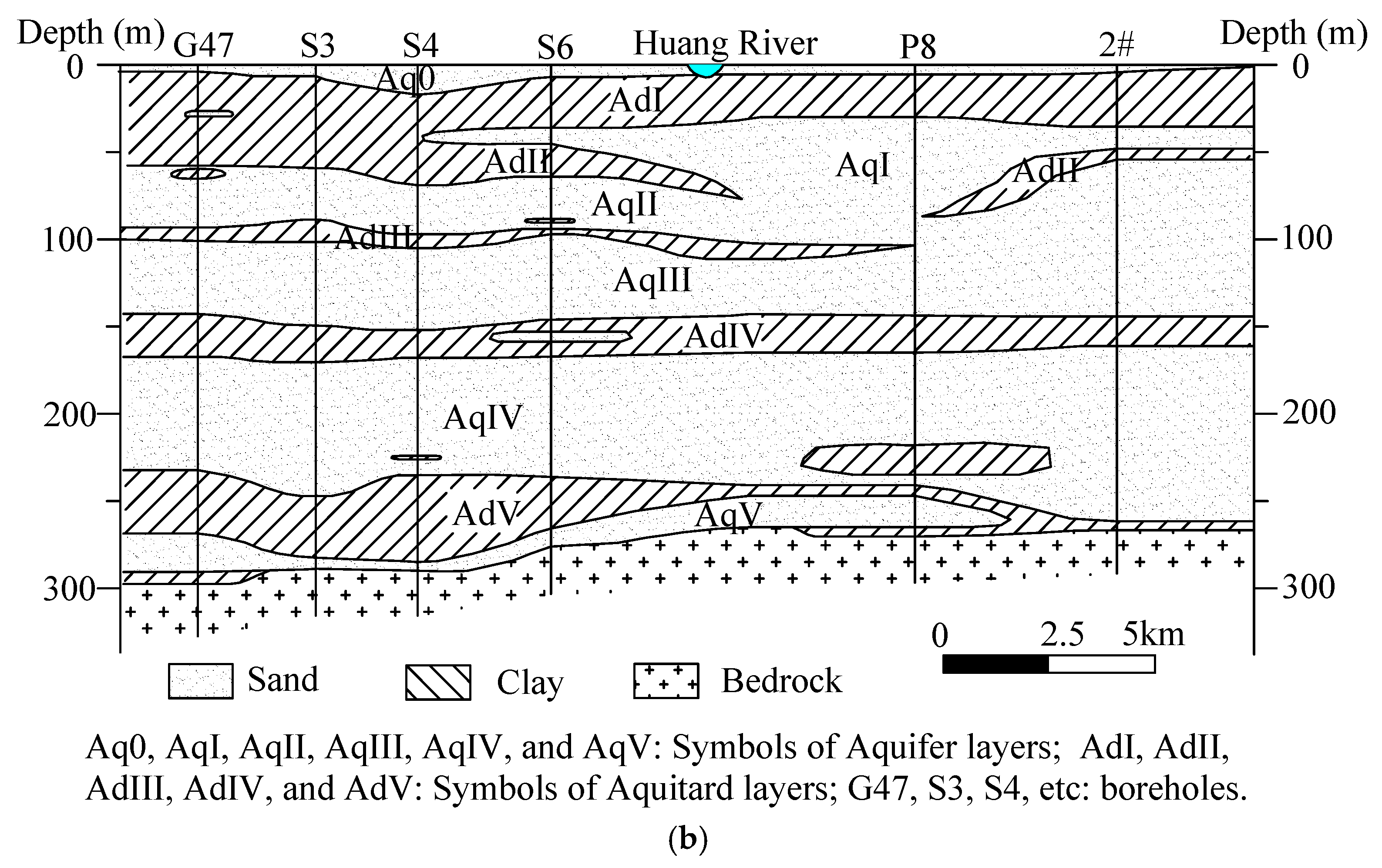

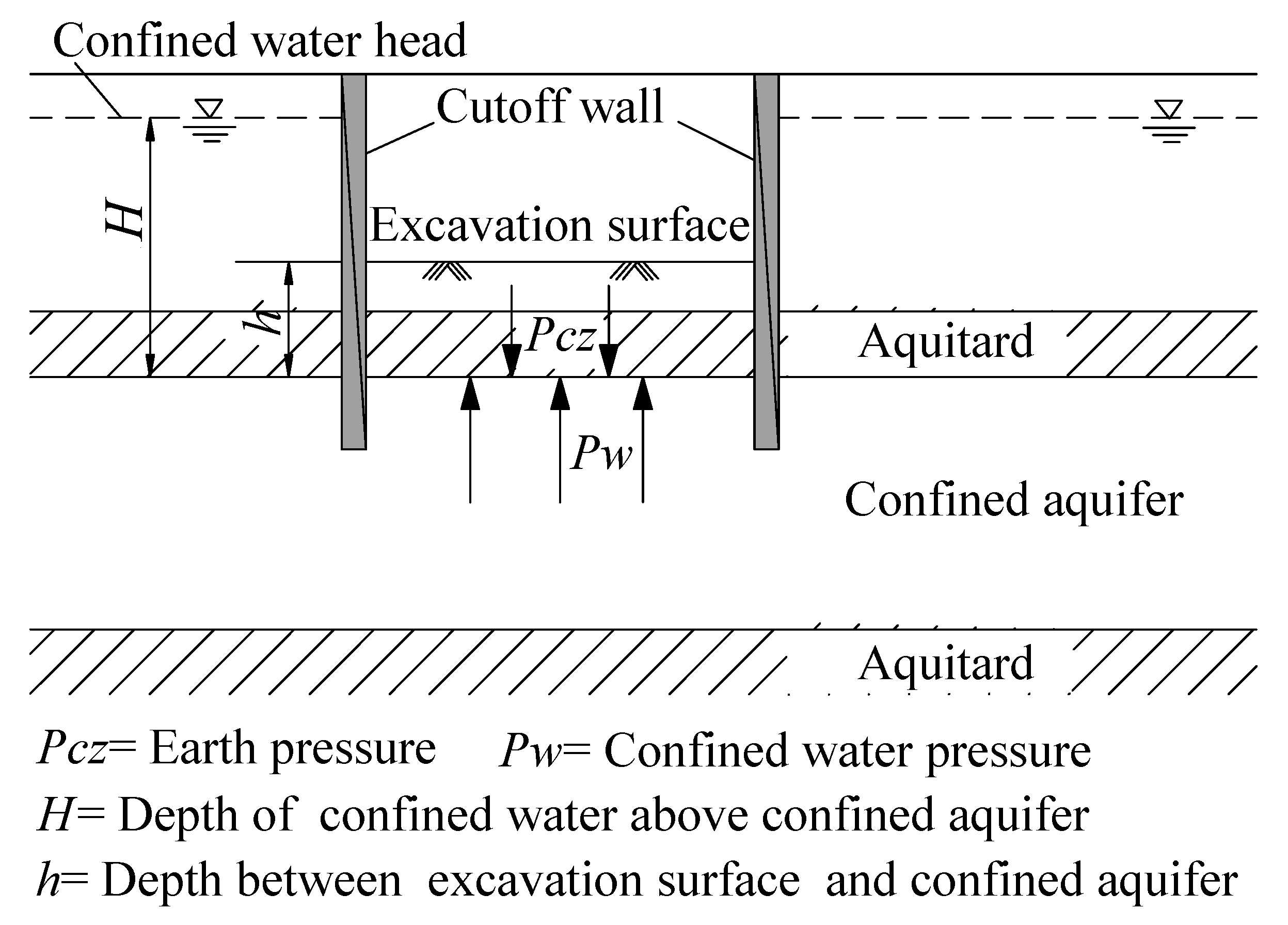
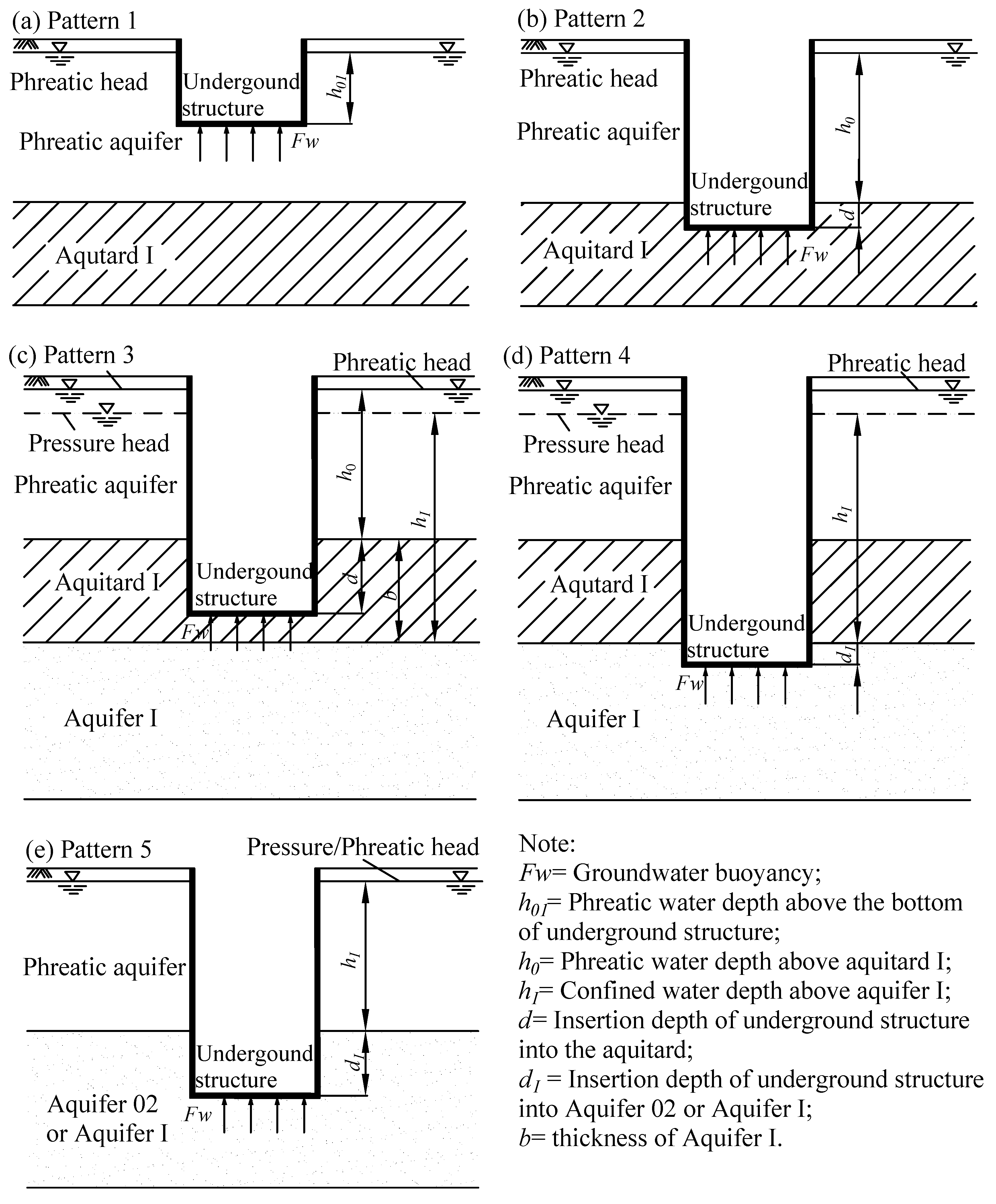
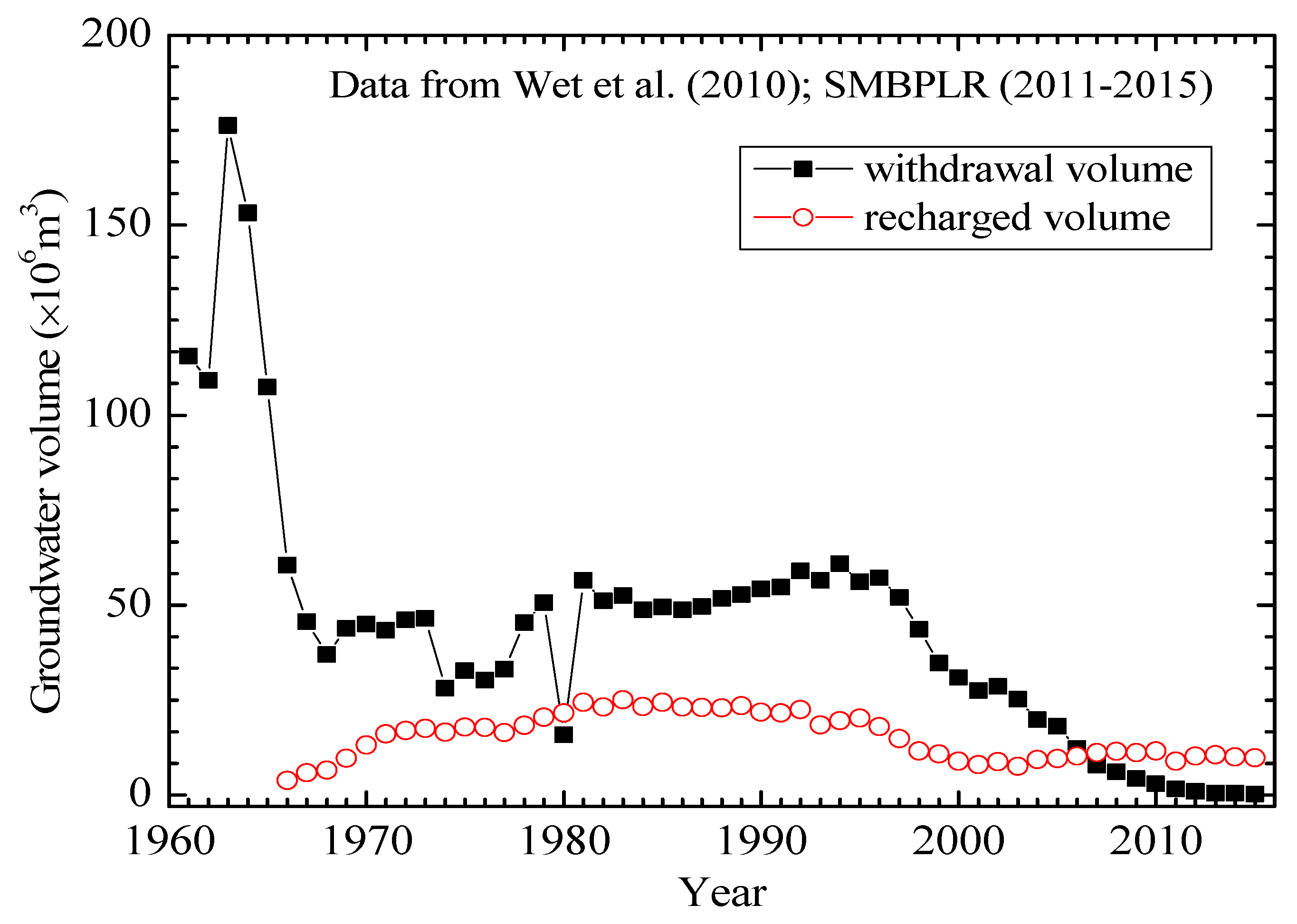
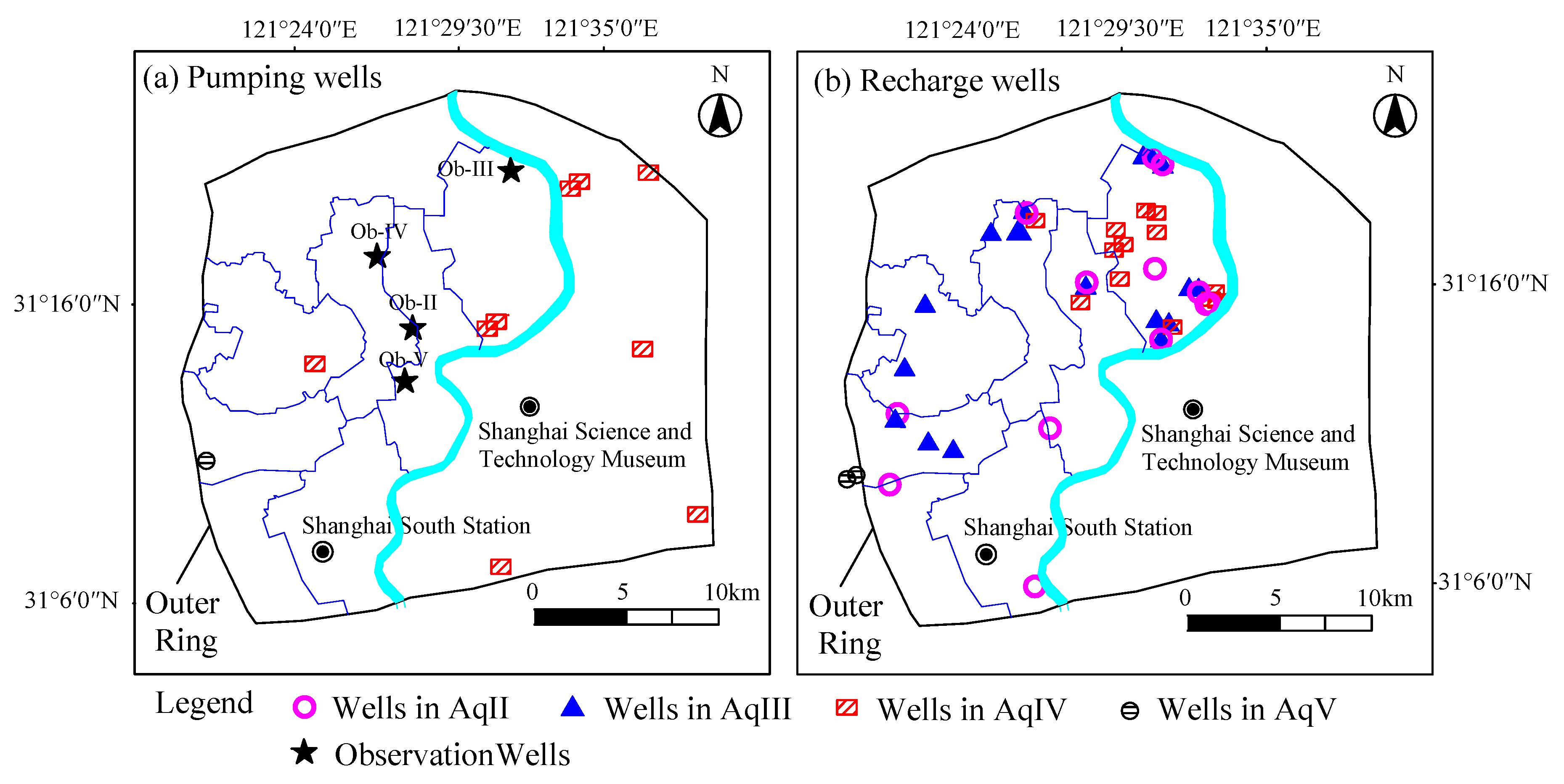
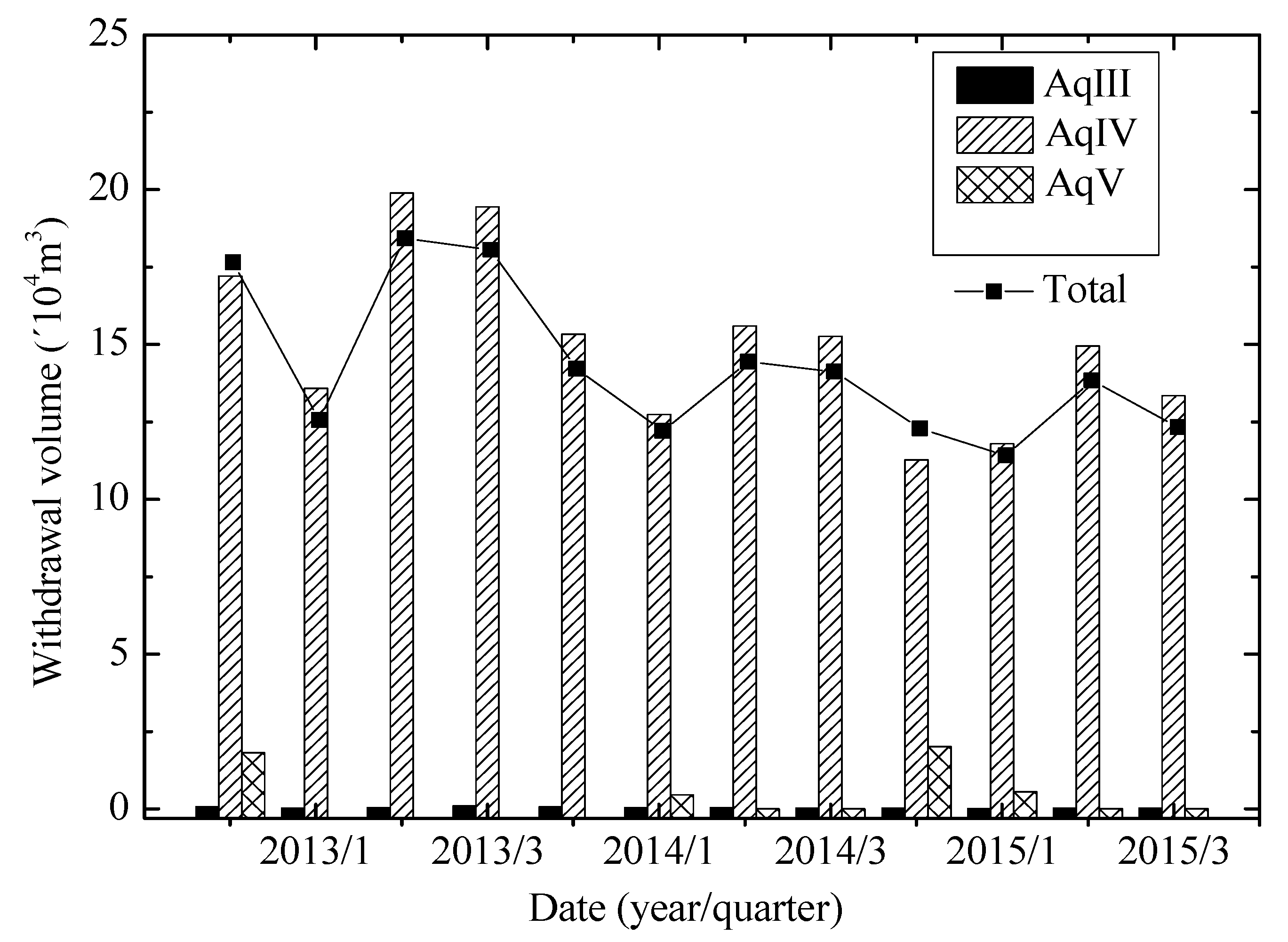
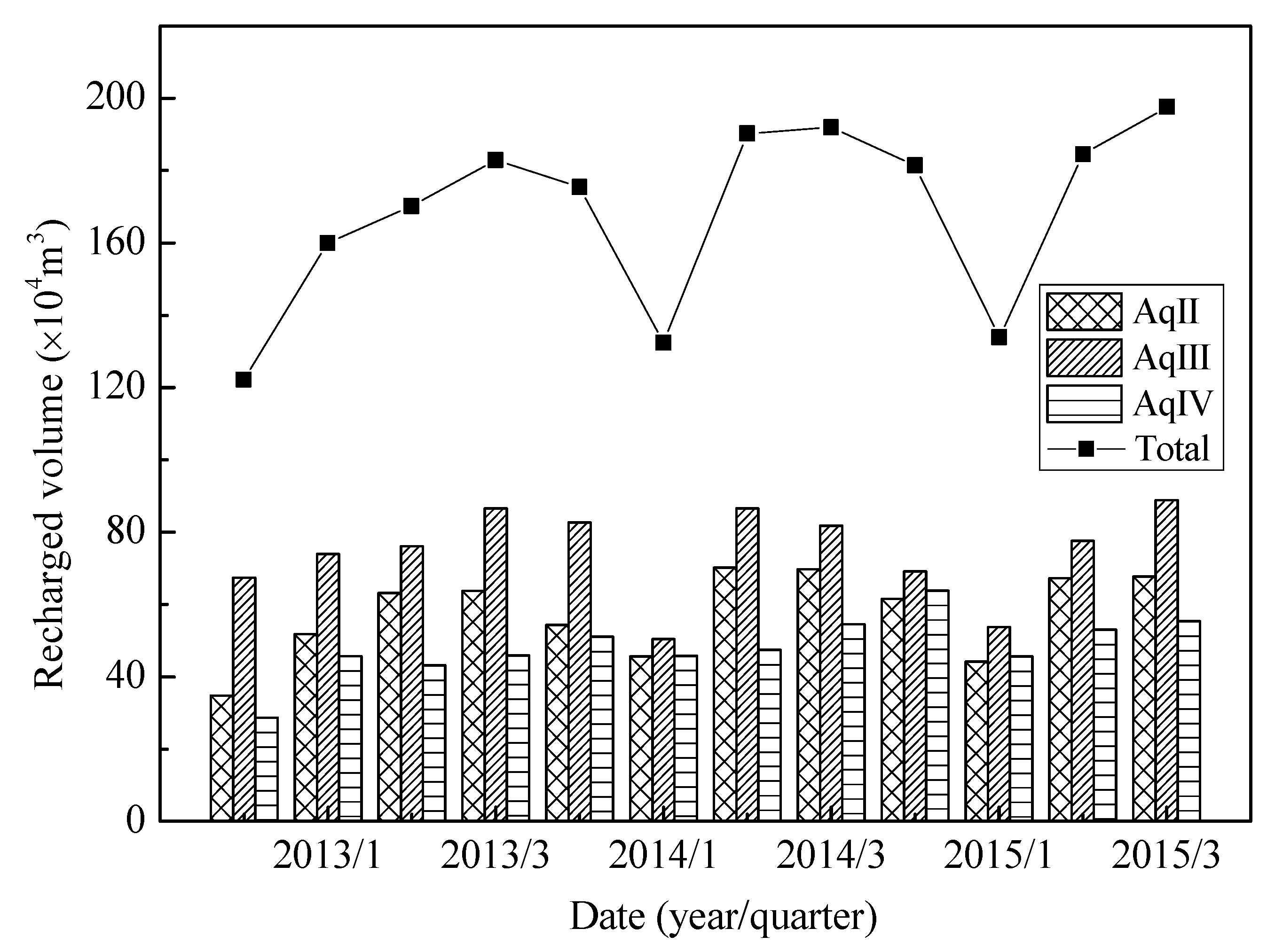
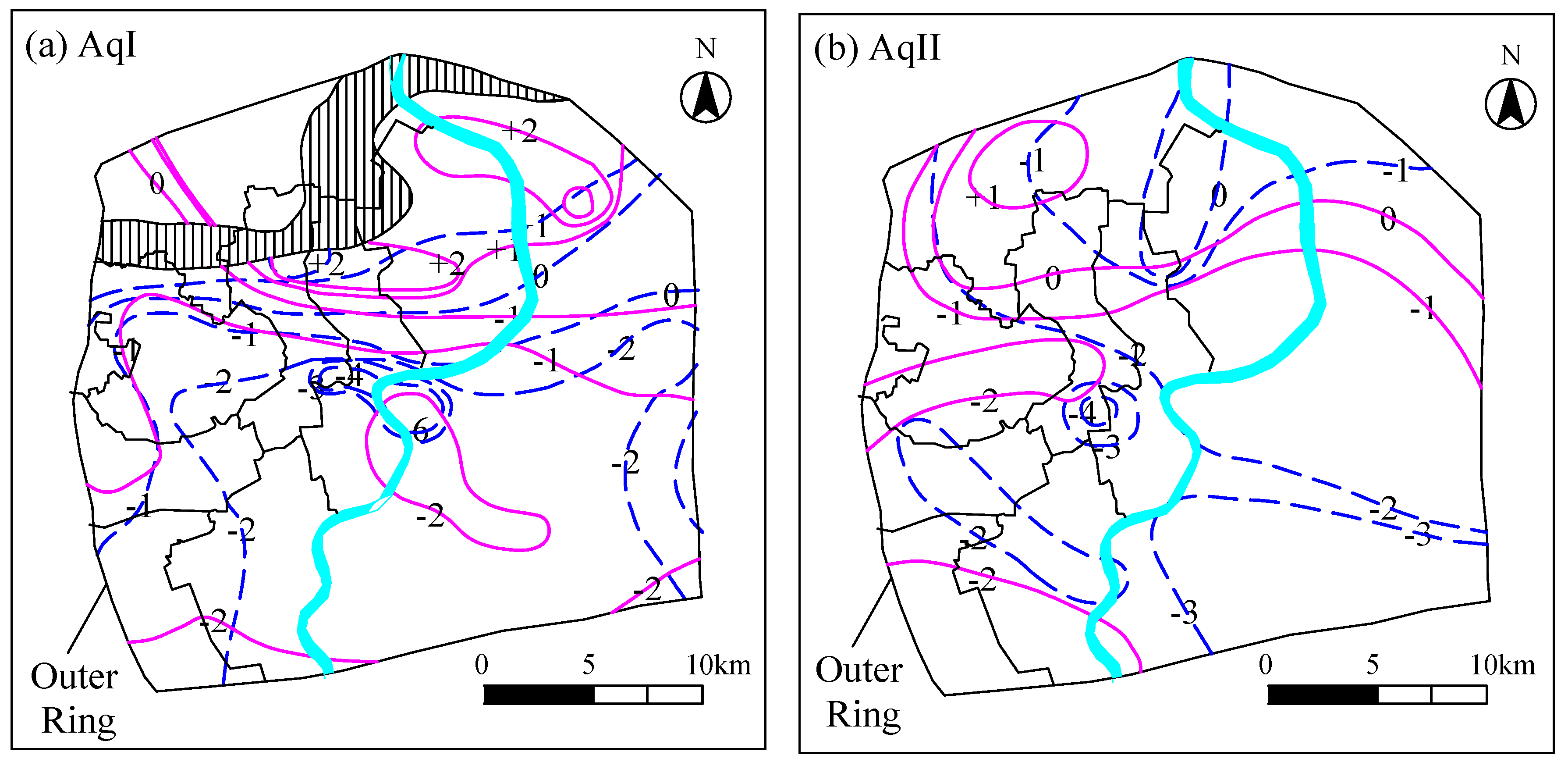
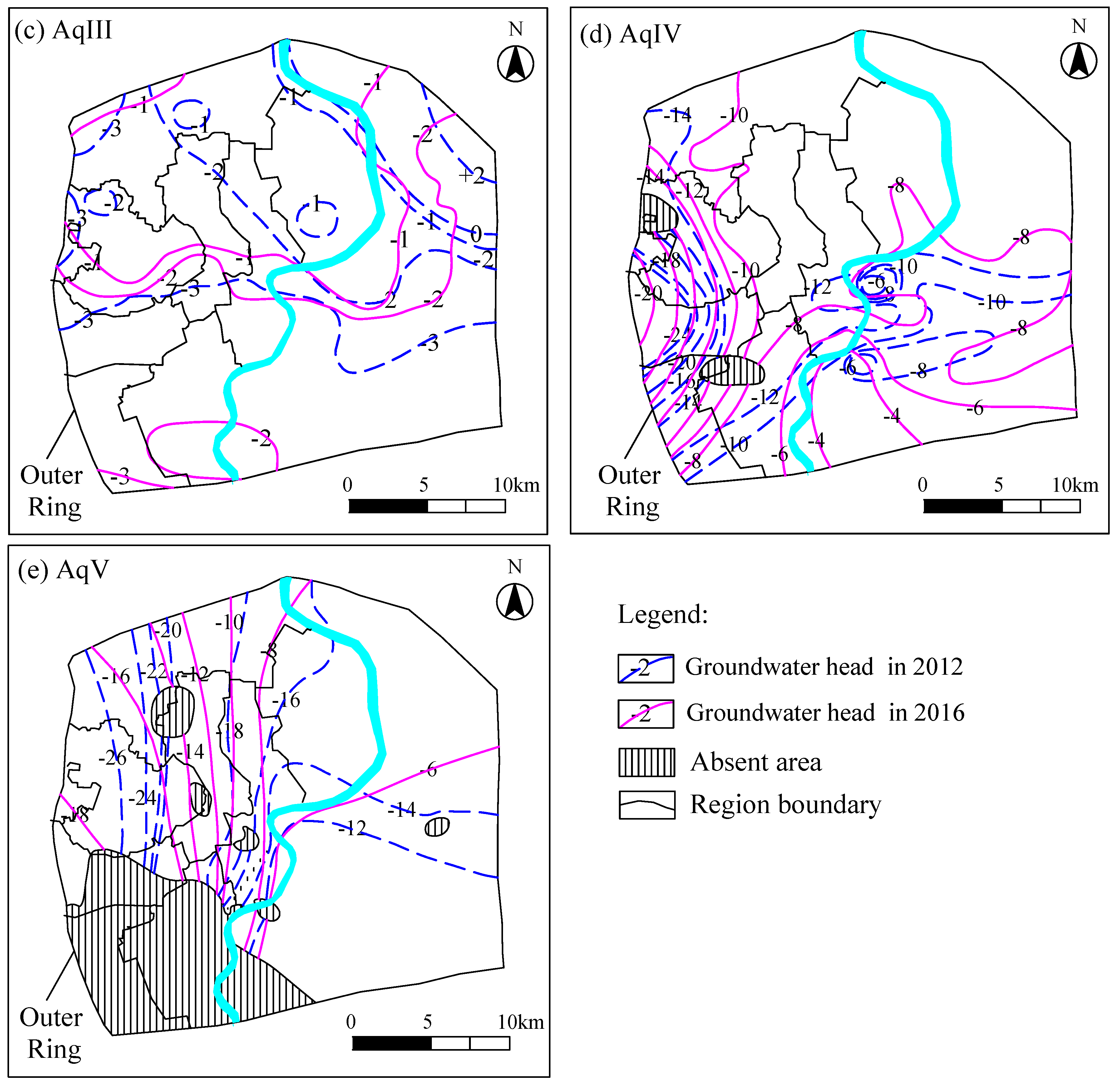
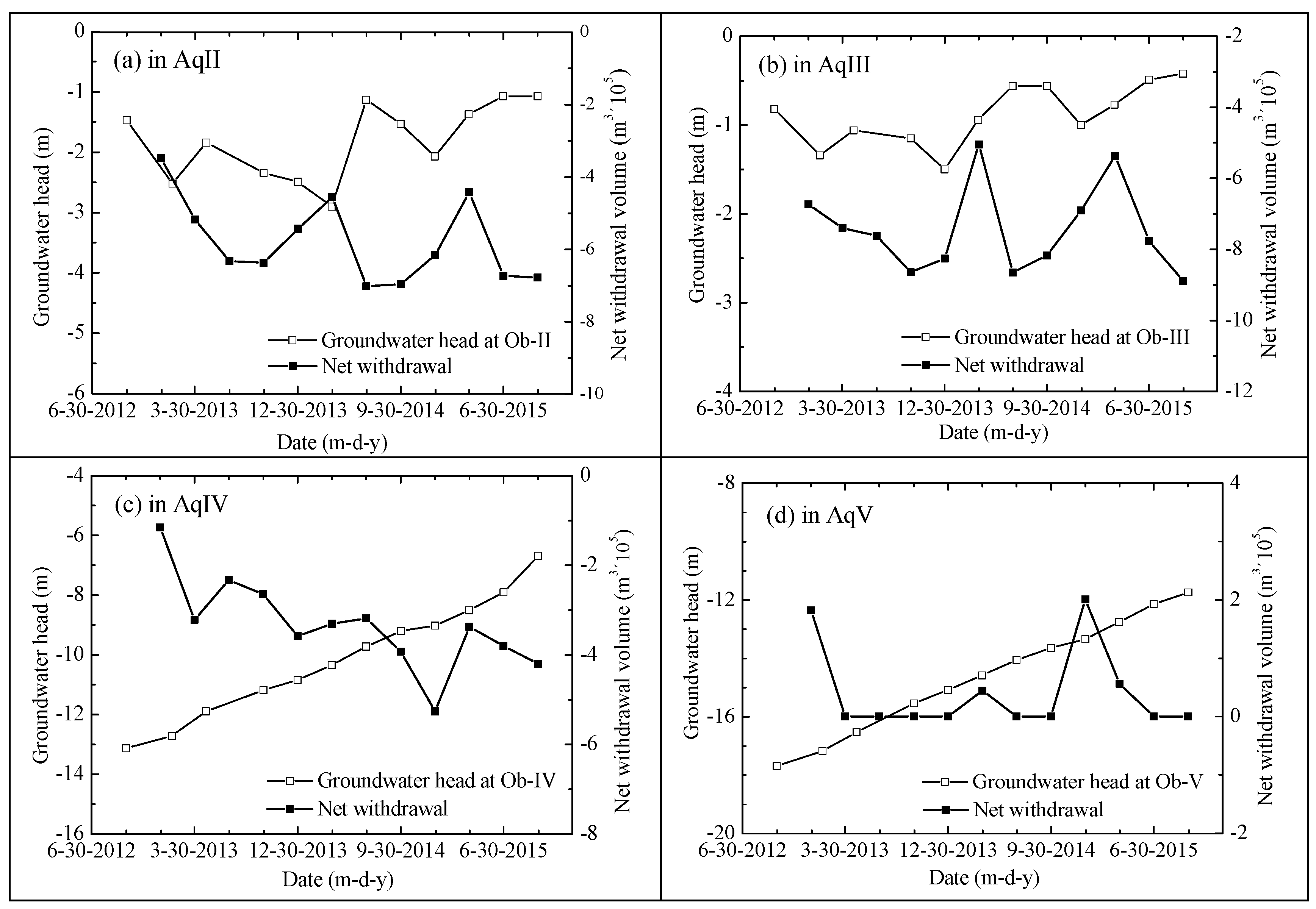

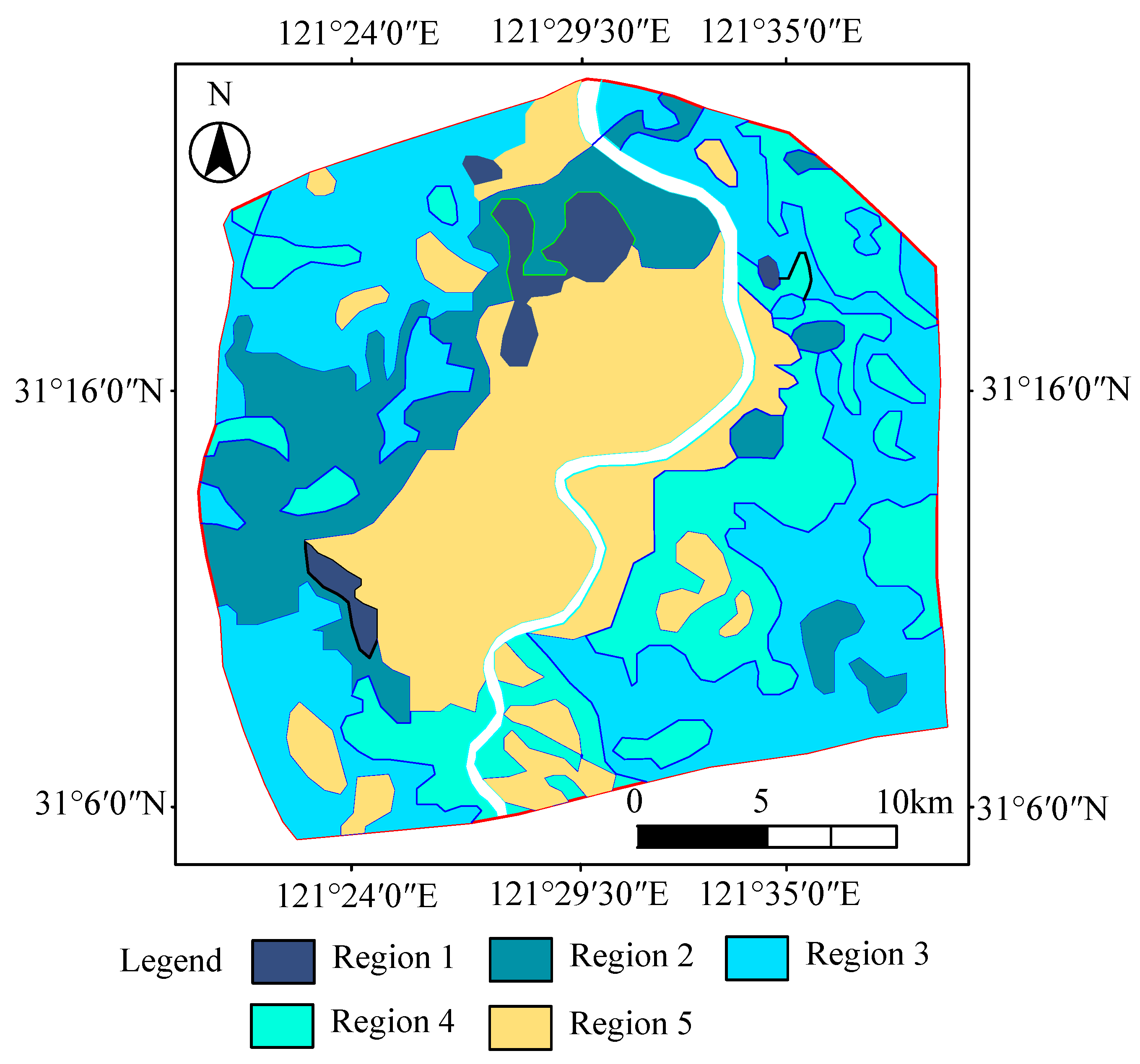
| Layer | kh (m/d) | kv (m/d) | T (m2/d) | S | SDC (m3/d·m) |
|---|---|---|---|---|---|
| Aq0 | 0.01–1 | 0.001–0.1 | 0.05–20 | 10−6–10−5 | 0.48 ~ 43.2 |
| Aq I | 0.6–31 | 0.06–3.1 | 6–1000 | 10−6–10−5 | 36 ~ 48 |
| AqII | 5–65 | 0.5–6.5 | 450–1500 | 10−5–10−4 | 240 ~ 720 |
| AqIII | 7–40 | 0.7–40 | 300–1000 | 10−5–10−4 | 240 ~ 480 |
| AqIV | 1–50 | 1–5 | 50–2000 | 10−5–10−4 | 480 ~ 720 |
| AqV | 1–20 | 0.1–2 | 50–500 | 10−5–10−4 | <120 |
| Regions | Characteristics | Hydrogeology Condition | Top Elevation(m) | Pressure Head (m) | Critical Excavation Depth (m) |
|---|---|---|---|---|---|
| Region I | Absent area of AqI | AqII | −63 | 0.45 | 27.8 |
| Region II | Shallow buried area of AqI | AqI | −19 ~ −27 | 2.0 | 9.2 ~ 12.3 |
| AqII | −63 ~ −67 | 1.0 | 26.9 ~ 28.4 | ||
| Region III | Moderate buried area of AqI | AqI | −27 ~ −35 | 0.5 | 13.2 ~ 16.3 |
| AqII | −67 ~ −70 | 0 | 29.1 ~ 30.2 | ||
| Region IV | Connected zone of AqI and AqII | AqI/AqII | −27 ~ −43 | 0.8 | 13.1 ~ 19.2 |
| Region V | Deeply buried area of AqI | AqI | −35 ~ −51 | −2 | 17.8 ~ 24.1 |
| AqII | −57 ~ −63 | −2 | 26.4 ~ 28.7 | ||
| Region VI | Aq02 distribution and disconnected area of AqI and AqII (VI1) | Aq01 | −10 ~ −20 | −1.5 | 7.8 ~ 11.7 |
| AqI | −27 ~ −43 | −1.5 | 14.1 ~ 20.3 | ||
| AqII | −56 ~ −68 | −1 | 25.4 ~ 30.0 | ||
| Aq02 distribution and connected area of AqI and AqII (VI2) | Aq01 | −20 ~ −30 | −1.5 | 11.7 ~ 15.6 | |
| AqI | −27 ~ −43 | −0.35 | 13.7 ~ 19.9 | ||
| AqII |
| Regions | Ground Elevation (m) | Designed Anti-Floating Head (m) | Critical Groundwater Head (m) |
|---|---|---|---|
| Region 1 | 1.0–1.5 | 0.5–1.0 | 0.5 |
| Region 2 | 1.5–2.0 | 1.0–1.5 | 1.0 |
| Region 3 | 2.0–2.5 | 1.5–2.0 | 1.5 |
| Region 4 | 2.5–3.0 | 2.0–2.5 | 2.0 |
| Region 5 | 3.0–4.0 | 2.5–3.5 | 2.5 |
© 2019 by the authors. Licensee MDPI, Basel, Switzerland. This article is an open access article distributed under the terms and conditions of the Creative Commons Attribution (CC BY) license (http://creativecommons.org/licenses/by/4.0/).
Share and Cite
Wu, Y.-X.; Yang, T.-L.; Li, P.-C.; Lin, J.-X. Investigation of Groundwater Withdrawal and Recharge Affecting Underground Structures in the Shanghai Urban Area. Sustainability 2019, 11, 7162. https://doi.org/10.3390/su11247162
Wu Y-X, Yang T-L, Li P-C, Lin J-X. Investigation of Groundwater Withdrawal and Recharge Affecting Underground Structures in the Shanghai Urban Area. Sustainability. 2019; 11(24):7162. https://doi.org/10.3390/su11247162
Chicago/Turabian StyleWu, Yong-Xia, Tian-Liang Yang, Pei-Chao Li, and Jin-Xin Lin. 2019. "Investigation of Groundwater Withdrawal and Recharge Affecting Underground Structures in the Shanghai Urban Area" Sustainability 11, no. 24: 7162. https://doi.org/10.3390/su11247162
APA StyleWu, Y.-X., Yang, T.-L., Li, P.-C., & Lin, J.-X. (2019). Investigation of Groundwater Withdrawal and Recharge Affecting Underground Structures in the Shanghai Urban Area. Sustainability, 11(24), 7162. https://doi.org/10.3390/su11247162





